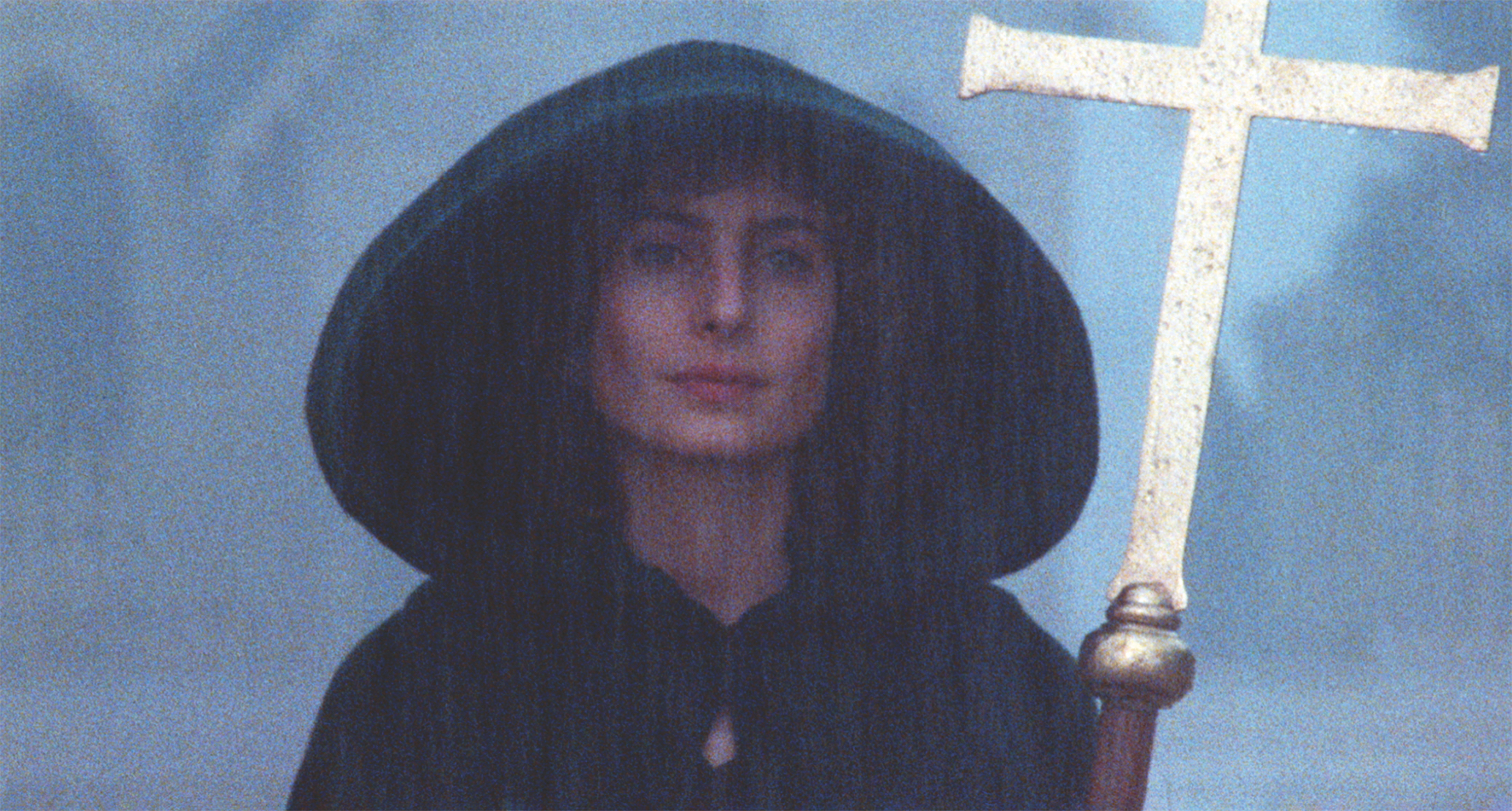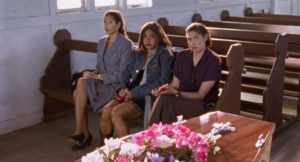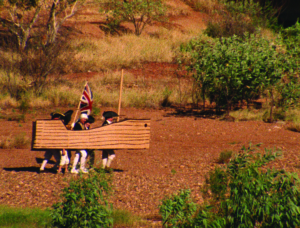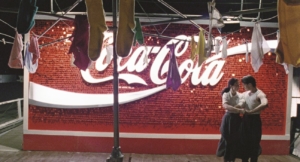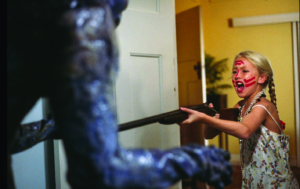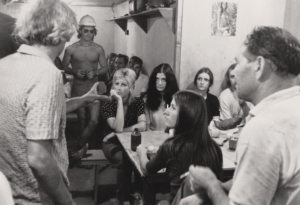Bliss (Ray Lawrence, 1985) is a film no-one quite knows what to do with. Despite winning several of the major categories at the 1985 Australian Film Institute (AFI) Awards, it’s a movie that doesn’t fit neatly within accounts of Australian cinema history. While some prominent critics such as Paul Byrnes have been fulsome and consistent in their praise over time,[1]See, for example, Paul Byrnes, ‘Bliss – New Team Delivers Landmark Australian Film’, The Sydney Morning Herald, 19 September 1985. Bliss is still not widely discussed in generalist accounts of Australian cinema, even those that focus on the production boom and increasingly disparate output of the 1980s. Susan Dermody provides passingly positive commentary while positioning it within an ‘eccentric’, low-key strand of production largely centred in Melbourne; though Bliss, of course, is a profoundly Sydney film and less constrained in its form and sensibility than its sisters in this category. But even she regards Bliss as an anomaly, seeing it as a film – alongside the ragtag bunch of Mouth to Mouth (John Duigan, 1978), Malcolm (Nadia Tass, 1986) and The Year My Voice Broke (Duigan, 1987) – ‘that got away in another sense, into the mainstream marketplace’.[2]Susan Dermody, ‘The Company of Eccentrics’, Filmnews,1 December 1988, p. 6. Tom O’Regan positions it as an ‘art’ film in his quadripartite categorisation of the Australian cinema of this period.[3]O’Regan divides the ‘films’ of the 1980s into four dominant categories: genre, art film, blockbusters and TV miniseries. See Tom O’Regan, ‘The Enchantment with Cinema: Film in the 1980s’, in Albert Moran & O’Regan (eds), The Australian Screen, Penguin Books, Ringwood, Vic., 1989, p. 130. Scott Murray, less predictably, questions Bliss’ ‘fractured approach’ as it moves between ‘odd moments of successful shock, and others of plain silliness’, while lamenting that Lawrence is often ‘unable to stop his film jerking along, and often just dying’.[4]Scott Murray, ‘Bliss’, in Murray (ed.), Australian Film 1978–1994, Oxford University Press, Melbourne, 1995, p. 164. Despite this, Murray also praises the movie for offering ‘one of the finest romantic resolutions in Australian cinema’.[5]Scott Murray, ‘Australian Cinema in the 1970s and 1980s’, in Murray (ed.), Australian Cinema, Allen & Unwin & Australian Film Commission, St Leonards, 1994, p. 134. David Stratton is characteristically more thorough in his accounting of the film’s inception, production, and commercial and critical fate, but his analysis of the text itself is limited in scope, inexactly and hyperbolically emphasising its ‘extremely audacious’ mix of ‘astonishing beauty, black humour, and the genuinely bizarre in almost equal proportions’.[6]David Stratton, The Avocado Plantation: Boom and Bust in the Australian Film Industry, MacMillan, Sydney, 1990, p. 177. While Stratton’s discussion does start to get at its curious, even mercurial qualities, he can’t adequately account for the film’s disarming mix of tones, styles, genres and modes of performance. Based on the Miles Franklin Award–winning novel by Peter Carey about an advertising man whose world is turned upside down after he ‘survives’ a heart attack,[7]Peter Carey, Bliss, London, Picador, 1982. Carey’s novel was first published in 1981 and won the Miles Franklin Award for that year. It also won the Christina Stead Prize for Fiction in the New South Wales Premier’s Literary Awards the following year. Bliss remains a singular fusion of tragedy and farce, social realism and surrealism, magic realism and family melodrama, the grotesque and the poetic, life and death, dream and reality, ecological critique and rhapsodic pastoral, heaven and hell, the postmodern and the prelapsarian. It also stands triumphantly as an allegedly ‘unfilmable’ yet widely celebrated literary source that has been successfully adapted to the screen.
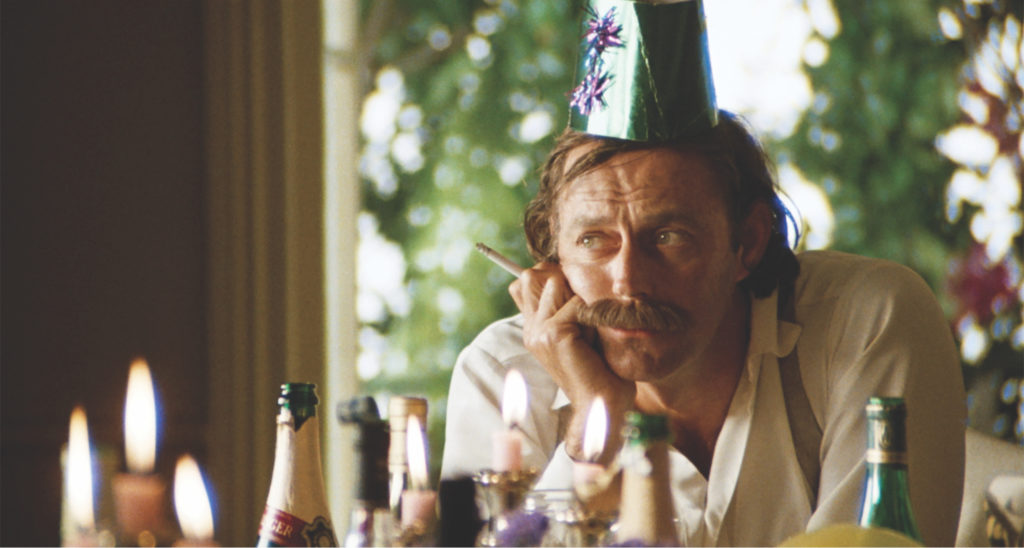
Bliss was notorious for the vehemence of its hostile initial reception at the Cannes Film Festival in mid May 1985, as well as the glee with which members of the – mostly – Sydney press reported on the hundreds of walkouts at these initial screenings.[8]This is particularly in reference to reports that appeared in newspapers such as Sydney’s The Daily Telegraph. But similar reports also appeared elsewhere: see, for example, ‘Film “Torture” for Cannes Critics’, The Canberra Times, 20 May 1985. This brief report also quotes Lawrence claiming he ‘felt like a criminal’ after the shock of seeing ‘40 people in front of [him] stand up and walk out’ at this initial screening. These reports mostly refer to the Cannes press screenings rather than the Gala showing of Bliss at the festival the following day. This response was part and parcel of a growing antipathy towards the Australian film industry and its output at this time, a sentiment partly fuelled by the levels of government support the industry was ‘still’ receiving ten years after the revival; the commercial and artistic failure of many of the films that had been released; and the often detrimental market-driven effects of the 10BA tax-incentive system then in place.[9]Division 10BA was first introduced in June 1981. It allowed investors to claim a 150 per cent tax concession on specific film investments. This percentage was gradually decreased across the decade. Most of the features produced during the period of its operation, including Bliss, were funded – at least in part – by these tax concessions. It led to increased production levels and budgets, and a higher percentage of movies that didn’t receive a theatrical release. Sympathetic Sydney Morning Herald journalist Richard Glover tried to account for this gloating response to Bliss in his lengthy report on the frenzied initial reception it received from the Australian press:
You can see it as a story of how Australians cut down tall poppies; as a story about the Australian media and how it works; or as an example of how a myth is being created among us, on little evidence, that the Australian film industry is artistically dead.[10]Richard Glover, ‘Media Slaughters Good Chance for Bliss’, The Sydney Morning Herald, 10 June 1985.
Bliss stepped into a highly contestable marketplace that reflected the increasingly transnational nature of film production and the general squeezing out of many ‘inward-looking’ Australian films.
Decades later, the film’s producer, Anthony Buckley, claimed that the international reception was actually generally positive, as reflected in complimentary reviews by prominent critics like David Thomson and Derek Malcolm after the Cannes screenings; its invitations to major film festivals such as London, New York and Sundance;[11]The recommendations of Thomson and Malcolm were central to getting the film invited to the New York and London film festivals. and the relatively wide release it received across various countries.[12]Anthony Buckley, Behind a Velvet Light Trap: A Filmmaker’s Journey from Cinesound to Cannes, Hardie Grant Books, Prahran, Vic., 2009, pp. 256–7. Buckley’s is, by some distance, the most detailed published account of Bliss’ production and release. He nevertheless also reminisced, ‘At home the press were to have a field day. It was open slaughter.’[13]ibid., p. 257. As Lawrence himself somewhat hyperbolically announced at the time to Glover, ‘[The film] has been killed by three gossip columnists who have never seen it and I’m stunned by their power.’[14]Ray Lawrence, quoted in Glover, ‘Media Slaughters Good Chance for Bliss’, op. cit.
But this response also needs to be positioned within a broader industry context. The year of 1985 was not a very successful one for Australian feature films either critically or commercially. It was blighted by the significant failure of prominent mid-to-large-budget Australian movies such as The Naked Country (Tim Burstall, 1985), Robbery Under Arms (Donald Crombie & Ken Hannam, 1985), Burke & Wills (Graeme Clifford, 1985) and The Empty Beach (Chris Thomson, 1985).[15]See Richard Glover, ‘Bliss Is a Hit at the Box Office’, The Sydney Morning Herald, 26 September 1985. In this article, Glover compares average box-office takings per week per cinema for a range of Australian films released in 1985. Bliss’ per-screen average of A$30,000 compares very favourably to Robbery Under Arms (A$4300) and The Naked Country (A$2800). Significant financial success was mainly restricted to movies with strong overseas connections: Peter Weir’s Paramount-produced and US-shot Witness (1985); and Mad Max: Beyond Thunderdome (George Miller & George Ogilvie, 1985).[16]Witness is, of course, an American-produced and -shot film, but it was still commonly brought into these discussions due to several of its key production personnel being Australian. Even the considerably less feted Mrs. Soffel (1984), Gillian Armstrong’s first US-produced and -shot movie, remained one of the more successful Australian-related films at the box office that year. As a result of this, Bliss stepped into a highly contestable and even questionable marketplace that reflected the increasingly transnational nature of film production and the general squeezing out of many ‘inward-looking’ Australian films.[17]For a discussion of the ‘outward-looking’ trend in contemporary Australian cinema, see Ben Goldsmith, ‘Outward-looking Australian Cinema’, Studies in Australasian Cinema, vol. 4, no. 3, 2010, pp. 199–214. The following year, of course, saw the release of the film that joined these two traditions together, going on to become the most financially successful Australian film of all time at the local box office: Crocodile Dundee (Peter Faiman, 1986).[18]Despite being released over thirty years ago, Crocodile Dundee remains by far the most financially successful Australian film released at the local box office. Its only competition are several international blockbusters made by Miller and Baz Luhrmann that also attained significant overseas success but were largely financed by Hollywood studios. For more on the film and its legacy, see Jake Wilson, ‘Hogan’s Heroes: Star Image in Dean Murphy’s The Very Excellent Mr. Dundee’, in this issue of Metro, pp. 18–21.
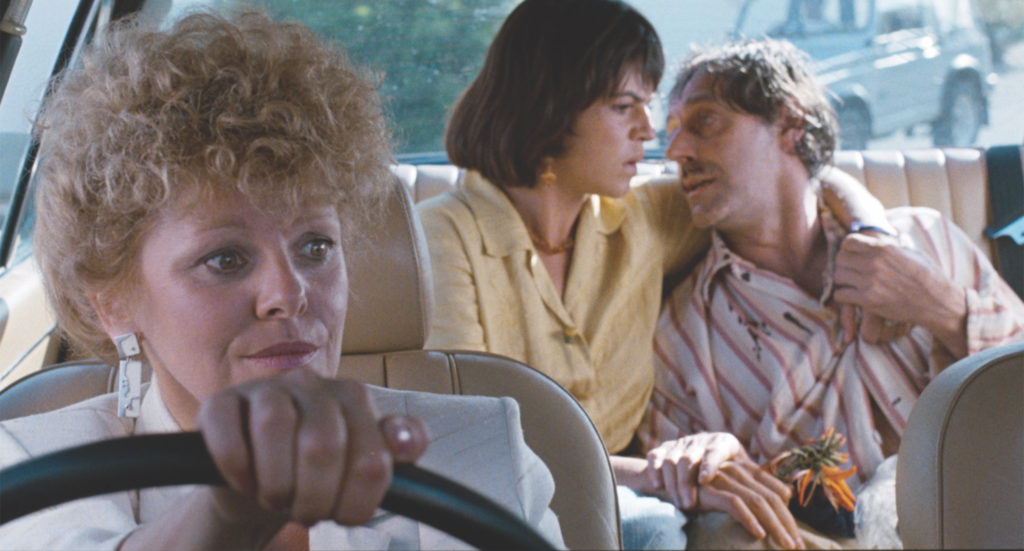
Partly as a result of this situation, Bliss struggled to find distribution and exhibition in its home market. It was rejected by various distributors before being taken on by its principal backer, the New South Wales Film Corporation (NSWFC). Such a move was highly unusual but reflected the mixed response to and even hopes for the film, the problems it would also have with the Commonwealth Film Censorship Board, and the difficulties it seemingly posed in attracting potential audiences.[19]I will discuss these censorship problems later in this article, but these mainly revolved around the film initially receiving an R rating and the negative impact this would likely have had on its commercial fate. Its fate started to turn with the decision by the NSWFC to enter the field of distribution; its success at the AFI Awards in mid September 1985, just days before release;[20]The twenty-seventh AFI Awards took place in Sydney on Saturday 14 September 1985. The ceremony also included a truly bizarre musical number featuring three dancers representing the two central characters from Bliss and the ‘religious’ figure glimpsed in the film’s opening moments and featured on its poster design. The brevity of this performance was, I’m sure, a relief to everyone. and a subsequent move from the 173-seat State 2 to a much larger, 480-seat cinema at the Greater Union Pitt Centre in Sydney on the back of the prizes it won as well as its increasing notoriety.[21]Buckley, Behind a Velvet Light Trap, op. cit., pp. 261–2. On its initial run, Bliss was screened at a smaller venue in Melbourne.
This controversy also provided an important impetus and focal point for the film’s marketing. For example, one of its posters provocatively claimed that ‘Cannes created the controversy’ and asked audience members to ‘judge for yourself’. The potential success of Bliss at the Australian box office was also boosted by the generally positive reviews that had started to appear in the daily press and that commonly highlighted its unusual and generally refreshing qualities. For example, while acclaiming its rarity as an Australian ‘film of ideas’, Byrnes went out on a limb to report that Bliss was
simply the best thing made here in a very long time. Not since Peter Weir’s Picnic at Hanging Rock burst upon the scene in 1975 has there been a film which so extends the bounds of what we have come to expect from Australian films, both in terms of form and content.[22]Byrnes, ‘New Team Delivers Landmark Australian Film’, op. cit.
These positive responses are also reflected in slightly later accounts by scholars such as Susan Dermody and Elizabeth Jacka:
In such a stagnant aesthetic climate, Bliss looks like a breakthrough, with its ‘fresh’ surrealism, its blurring of reality and dream, life and after-life, and the bizarre texture it creates with its black, Gothic view of Australian life.[23]Susan Dermody & Elizabeth Jacka, quoted in Robert Dixon, ‘Peter Carey’s and Ray Lawrence’s Bliss (1985): Fiction, Film and Power’, Studies in Australasian Cinema, vol. 3, no. 3, 2009, pp. 283–4.
This response pinpoints the broader critical context the film was released within. Nevertheless, in a manner also typical of many responses, Dermody and Jacka go on to qualify and question the novelty of the movie’s ‘formal experimentation’ by suggesting it was ‘anticipated as early as [Federico] Fellini’s work in the sixties, or even in eccentric seventies mainstream American films like Slaughterhouse Five [George Roy Hill, 1972]’.[24]ibid., p. 284. These comments also reflect on the film’s less parochial qualities and how it draws on forms and traditions well beyond Australian cinema. But as I’ve established here, the broader context of Bliss’ release is central to understanding its initial reception, the difficulties it encountered before being successfully exhibited, and its subsequent critical reputation and partial neglect.
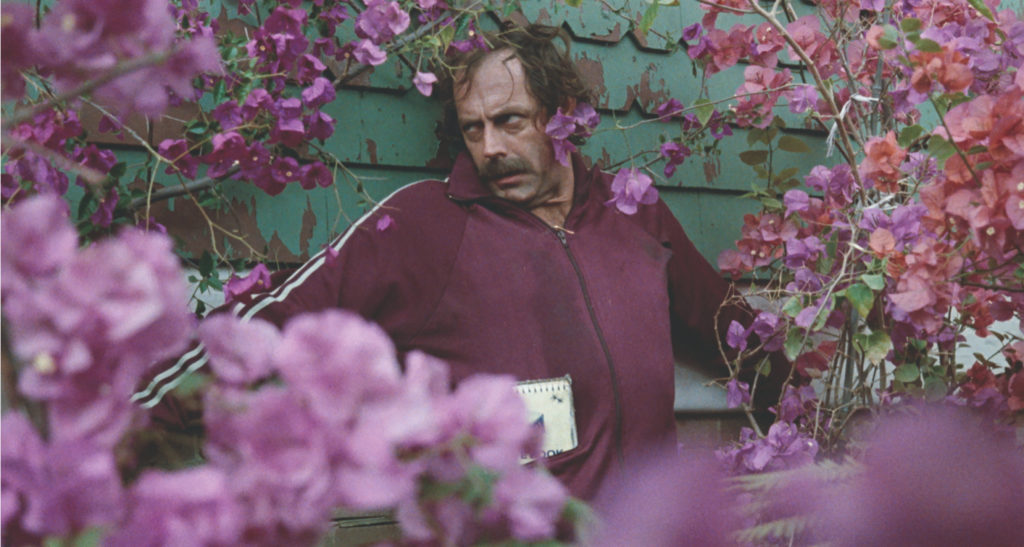
Selling Bliss: Ray Lawrence, Anthony Buckley and Peter Carey
Bliss came about through the connections and friendships forged between its three key creative forces: first-time feature director Lawrence, writer Carey and producer Buckley. Lawrence and Carey had met during their long stints working in the advertising industry.[25]Lawrence worked in advertising in the UK and Australia during the 1960s and 1970s. By the early 1980s, Lawrence was widely regarded as one of Australia’s best creative television-advertising directors, helming highly effective and lucrative campaigns for a wide array of clients including Holeproof, Bornhoffen, the State Bank of Victoria, IBM and Australia Post.[26]Some of the most fondly remembered of Lawrence’s commercials are for Bornhoffen bread, Holeproof and the Yellow Pages (featuring a character searching the directory for someone who’s heard of a Goggomobil). Each is carefully cast and relies upon a strong – if brief – story. For example, his commercial for Holeproof Computer Socks places this product’s ‘inventor’ alongside Isaac Newton on a bench outside a patent office. The theory of gravity is contested between the two of them, with Computer Socks refuting Newton’s theorem. Although the transition from television commercials to feature-film production is not always straightforward or even advisable, Lawrence’s forte as director was in staging dialogue and character-driven scenarios highly dependent on performance. As journalist Michael Meagher put it, ‘Lawrence’s commercial reel is characterised by ads that are either vignettes of everyday life or unusual situations. His speciality has been dialogue.’[27]Michael Meagher, ‘Ray Lawrence Feels Bliss, at Last’, The Bulletin, vol. 104, no. 5411, 10 April 1984, p. 75. There had also been significant precedent within Australia for highly regarded directors such as Fred Schepisi to move from commercials and short-form documentaries into features – in fact, in the often-moribund film and television industries of the 1960s and early 1970s, commercials were one of the few places where directors could work with highly experienced crews and adequate budgets and hone their craft. The impact of Lawrence’s extensive prior experience in commercials can also be evidenced by the episodic form and careful production design of Bliss and its structuring around a large number of individual scenes and set-ups. Over the subsequent thirty-five years, Lawrence has remained a significant director of television commercials and has only completed two more features: the highly successful Lantana (2001) and Jindabyne (2006), both deploying Altmanesque multiple-character forms and overlapping narrative structures.[28]Lawrence was involved in developing several other projects across this period, including an early planned adaptation of Robyn Davidson’s Tracks. The subject of numerous iterations, it was finally adapted to screen by John Curran and released in 2013. Careful adaptation has remained a key element of all of Lawrence’s feature films. Despite the small number of features Lawrence has made, he remains one of Australia’s most celebrated and critically successful film directors.
Buckley had long worked within the film industry, getting his first significant breaks as editor of two important international productions, Michael Powell’s Age of Consent (1969) and Ted Kotcheff’s Wake in Fright (1971).[29]Buckley had previously worked as an editor for Cinesound and Channel Ten. He was also the director and producer of various short films as well as two groundbreaking documentaries on pre-sound Australian cinema: Forgotten Cinema: The Golden Age of Australian Motion Pictures (1967) and Snow, Sand and Savages: The Life of Frank Hurley (1972). By the time he came to Bliss, Buckley had already produced five other features, though only one, Caddie (Donald Crombie, 1976), had been a significant commercial and critical success.[30]Prior to Bliss, Buckley had also produced The Irishman (Crombie, 1978), The Night, the Prowler (Jim Sharman, 1978), The Killing of Angel Street (Crombie, 1981) and Kitty and the Bagman (Crombie, 1982). Nevertheless, he brought significant experience and industry knowledge to the team and was integral to the film’s ultimate success. It was Buckley who insisted on entering Bliss in Cannes and who most doggedly pushed for its wider and more lucrative local release.
Carey is, of course, one of Australia’s most successful writers. Although he had produced two collections of short stories – The Fat Man in History (1974) and War Crimes (1979) – Bliss, his first published novel, was his breakthrough as a writer, winning multiple awards and becoming a rare work to be adapted to film, opera and the stage. Carey maintained his advertising practice, including his own company (McSpedden Carey Advertising Consultants, formed in 1980), until the early 1990s, and several of his other novels and stories have been made into feature films: Dead End Drive-In (Brian Trenchard-Smith, 1986); Oscar and Lucinda (Armstrong, 1997); and True History of the Kelly Gang (Justin Kurzel, 2020).[31]For more on True History of the Kelly Gang, see ‘The Pen Is Mightier than the Gun: Justin Kurzel’s True History of the Kelly Gang and Punk Historiography’, Metro, no. 203, 2020, pp. 6–13. Carey was also the co-writer of the screenplay of Wim Wenders’ Until the End of the World (1991).
Formative steps: From novel to screen
Carey and Lawrence had been working on other feature-film scripts prior to their decision to adapt Bliss to the screen. Despite their alleged quality, neither of these scripts received much interest from potential producers, and it was only when Lawrence gave him a copy of Carey’s novel that Buckley suggested that they should move on to adapting it instead. After returning from a trip to Kuala Lumpur, the producer proclaimed it to be ‘the most remarkable book’ he had read in ‘all [his] life’,[32]Buckley, Behind a Velvet Light Trap, op. cit., p. 245. and was surprised by others’ responses to it:
I met people who’d read the book and said, ‘How are you going to turn that into a film?’ I find that intriguing, because I’ve always seen the book as a film: I thought it was so visual.[33]Anthony Buckley, quoted in Peter Galvin, ‘Bliss in a Sometimes Joyless World’, Cinema Papers, no. 54, November 1985, p. 16.
This failure to see the cinematic potential in Carey’s novel is also surprising considering that it centres on the dynamic character of Harry Joy, an advertising account executive who has a knack for telling spellbinding stories but who subsequently undergoes a change of perspective and perception when he suffers a heart attack and lies ‘dead’ for four minutes. He then spends much of the rest of the narrative uncertain as to whether he is on Earth or in hell. This confusion is compounded by many of the surreal events and incidents he encounters, including visions of cockroaches crawling from his body; an elephant sitting on his car; the ribald, incestuous sexual exploits of his family members; the counterintuitive practices of his partners at his advertising agency; his Kafkaesque confinement in a psychiatric institution ruled by the lure of money and ‘mistaken’ identity; and his love affair with young ‘amateur’ sex worker Honey Barbara, who is seeking money to support her alternative community in the rainforests of New South Wales. In the last part, he retreats to this community to seek out and express his love for Honey Barbara and reject the poisonous materialism that has corrupted his life in the city.
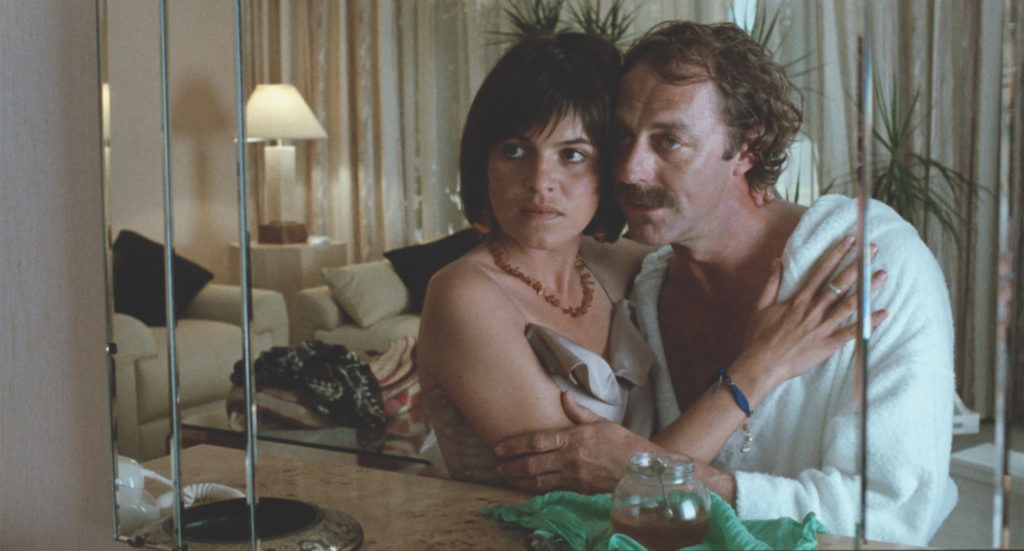
The problem here may have been one of perception. Rather than being an ‘unfilmable’ novel, Bliss just wasn’t the kind of material commonly adapted to film in Australia at this time. It is hard to imagine that Lawrence and Carey wouldn’t have partly identified with their central character or have at least considered his travails an interesting synecdoche for their own experiences – Carey had even written the novel while on retreat in the hinterland around Yandina, north of Brisbane. During the second half of the 1970s, Carey lived mostly in an alternative community in this region, travelling to Sydney for one week out of every month to fulfil his paid role at his advertising agency. Nevertheless, despite Buckley’s contagious enthusiasm, the team still had to overcome another significant obstacle: the screen rights to the novel were held by a British producer who planned to proceed with Armstrong at the helm. When the option on the book lapsed in early 1983 after a failure to produce a workable screenplay, Buckley moved in to secure the rights with financial support from the NSWFC.[34]Buckley recounts the difficulties he encountered while trying to persuade the NSWFC to take the unusual step of supporting the production in this way. The NSWFC also put forward the name of a company, Quantum, that helped raise the significant private investment required. See Buckley, Behind a Velvet Light Trap, op. cit., pp. 247–8.
Windows III Productions was formed to produce the film. Despite attaining the rights, there were still hurdles to overcome before production could commence. Although the script does not have the full scale and breadth of Carey’s novel – a number of its narrative threads, such as the material set in South America focusing on Harry’s son, David, are eliminated, and the setting is shifted from Queensland to New South Wales (while still retaining its fetid, subtropical atmosphere) – it nevertheless presents a complex and ambitious canvas for a first-time director and writer (Lawrence and Carey got together every morning for two months between 6 and 9 to write the screenplay). The 167 separate scenes that were filmed constituted ‘a logistical nightmare’, which clearly suggests the difficulties that were ultimately encountered on the shoot.[35]Stratton, The Avocado Plantation, op. cit., p. 175. The number that made it into the final cut is considerably lesser, but still substantial.
Rather than being an ‘unfilmable’ novel, Bliss just wasn’t the kind of material commonly adapted to film in Australia at this time.
The funding of Bliss is also very much a reflection of its time. Although exhibitors like Greater Union and Hoyts would not commit to screening the film prior to seeing a complete version, the NSWFC committed to an investment of A$500,000 in late 1983 that allowed the producers ‘to issue a prospectus to raise the remainder of [the A]$3.3 million budget’.[36]Buckley, Behind a Velvet Light Trap, op. cit., p. 249. This was achieved through private investment enabled by the lucrative tax concessions allowed under 10BA. According to Buckley, the film ended up having 360 individual investors, many of whom probably had little idea of the content of the film, though perhaps some knowledge of the novel’s success and of Buckley and the NSWFC’s track record. To help attract substantive investment and secure the support of the NSWFC, the filmmakers filmed a test scene on 35mm with their two lead actors, Barry Otto (who plays Harry Joy) and Lynette Curran (who plays his wife, Bettina). This was important as, while the film does feature some familiar faces – including actors who’d appeared in television advertisements directed by Lawrence such as Paul Chubb, fondly remembered for his role in a Bornhoffen commercial[37]Lawrence also first encountered Otto when working on a commercial. See Meagher, op. cit., p. 75. – it is in no way a star-driven vehicle. Although Otto had appeared in smaller roles in Norman Loves Rose (Henri Safran, 1982) and Undercover (David Stevens, 1984), and was relatively well known in theatre circles, at forty-three he hadn’t had a starring role in features or television. Curran had had a longer career, including a heroically prolonged stint in Bellbird from 1967 to 1974 on the ABC, but she was generally not widely associated with feature films despite smaller parts in movies like Caddie and Heatwave (Phillip Noyce, 1982).This general lack of feature-film experience – with the exception of Buckley – grants a freshness to Bliss. Part of the reason that the film stood out when released in the mid 1980s was its palpable lack of obvious connection to the developing traditions of Australian cinema, particularly the period and ‘landscape’ forms closely associated with the so-called ‘AFC genre’, Ozploitation or the social realism of contemporaneous films like Fran (Glenda Hambly, 1985).
The increase in budgets and levels of production enabled by the 10BA tax concessions also made it difficult for films to attract talent and lock in schedules. At the time of the production of Bliss, many key figures were contracted to the big-budget Burke & Wills, and office and studio space was also in short supply. Nevertheless, this gave opportunities to practitioners like Paul Murphy, who – despite having previously fulfilled a range of assistant roles on features – received his first credit as director of photography on the technically challenging Bliss.[38]Murphy had previously worked on a range of features including The F.J. Holden (Michael Thornhill, 1977), In Search of Anna (Esben Storm, 1978) and Manganinnie (John Honey, 1980). Coincidentally, his next credit as DOP was for another Carey adaptation, Dead End Drive-In. This challenge is evident from the very first scenes. In the space of around six minutes, we move from the bravura staging of a rural flood sometime in the 1920s to a domestic dinner-table scene with Harry’s family and associates; a virtuosic crane shot that moves out from Harry’s prostrate body; a murky and nightmarish underwater scene; and, finally, a return to an extreme long shot that cranes back towards the earth amid the aftermath of Harry’s ‘death’. This transition is also accompanied by a shift from a voice telling us a tale of the ‘Vision Splendid’ to the story of Harry’s life and death. Although not every element of this opening is successful – the staging of the underwater scene, particularly the model of a monstrous figure whose mouth opens to expel a large fish, is not especially convincing – it is testament to the audacity of the filmmaking and storytelling on display. As the voiceover boldly states: ‘Harry Joy had been dead for four minutes – and he would never be quite the same again, let me tell you.’ Unlike the novel, which retains some distance between the narrator and the characters, we come to realise that the voice we hear is that of Harry, moving seamlessly (though with the patina of old age) between the diegetic character telling a story around the dinner table to an older, more omniscient figure recollecting the past.
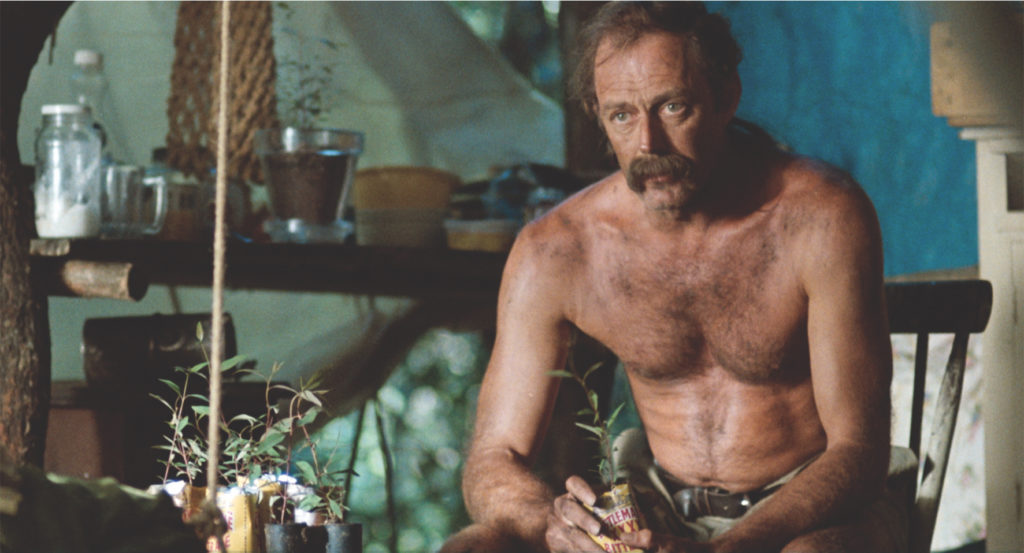
Biting the bullet
Pre-production on Bliss commenced on 6 August 1984,[39]Buckley, Behind a Velvet Light Trap, op. cit., p. 250. and included two weeks of rehearsals in the second half of September that were filmed on video. These then provided a key and ongoing point of reference for the fully developed and refined performances we see in the finished film. The production was carefully prepared, and ended up coming in on schedule and slightly under budget. As has been suggested, the shoot itself was technically complex and covered a wide array of locations and different set-ups. Principal shooting began on 10 October and lasted for approximately eleven weeks.[40]Stratton, The Avocado Plantation, op. cit., p. 175. The filming utilised a diverse range of locations, including the Strickland State Forest and a burnt-out area near Gosford; a house in Hunters Hill (the suburb in which Lawrence himself lived); a rural property in Richmond, north-west of Sydney (where the opening flood scene was shot); Rozelle Hospital; Newtown; the North Head Quarantine Station; the Pyrmont Bridge; Darling Harbour; Ryde; the Manly Pacific International Hotel; locations in East Sydney (including Honey Barbara’s rented lodgings); and the Royal Botanic Garden Sydney. It also utilised the facilities and spaces at Mort Bay Studios in Balmain for many of the interiors. Filming reportedly commenced with an exterior scene set at a garage in King Street, Newtown – establishing Bettina’s distaste for petrol as well as her relationship with her father – and generally stuck to schedule, despite some inclement weather, with only a few revisions. According to Buckley, the scenes to be shot in the burnt-out forest were shifted from Gloucester to Gosford to take advantage of an actual fire – saving a number of days and costs – and the opening scene, shot in Richmond, was refilmed after it was felt it didn’t capture the required atmosphere.[41]Buckley, Behind a Velvet Light Trap, op. cit., p. 254. This had a significant impact upon the production, he recounts, as ‘morale soared and the end result was absolutely perfect. A good example of finding ways to meet an “end” by being prepared to “bite the bullet”.’[42]ibid., p. 252.
Considerable time and effort were devoted to editing this complex and tonally varied film. This was difficult as the movie contains a number of striking moments that are explicitly surreal and even grotesque, visualising elements that have less materiality in the novel. We see cockroaches climbing out the body cavities of characters on a couple of occasions; Bettina and her husband’s business partner having sex on a table in a crowded restaurant; an elephant sitting on Harry’s crushed Fiat; and, most notoriously, fish slipping from between the legs of Bettina as she visits Harry in hospital, supposedly betraying her infidelity. These striking (if sometimes questionable) images sit alongside more grounded moments and scenes. For example, many of the passages with Honey Barbara (Helen Jones) – particularly while she is in Sydney – skirt closer to the feel and look of social realism. The film also takes time out to include more peripheral scenes that help develop a particular character or setting. For instance, there is a wonderful scene set in the psychiatric hospital that shows two young sea scouts being taught the pragmatic realities of the institution by its director – deliciously performed by Kerry Walker – in order to earn their badge (they have mistaken the hospital for the ginger factory nearby). The problems of piecing all of this together into a satisfying and coherent whole are reflected in the director’s response to an earlier edit of the film, as Stratton recounts:
Lawrence was deeply depressed after viewing the first rough cut, or assembly: it ran well over three hours. Getting to fine-cut stage was a difficult process, but Buckley (himself a former editor) was supportive and gave valuable advice.[43]Stratton, The Avocado Plantation, op. cit., p. 176.
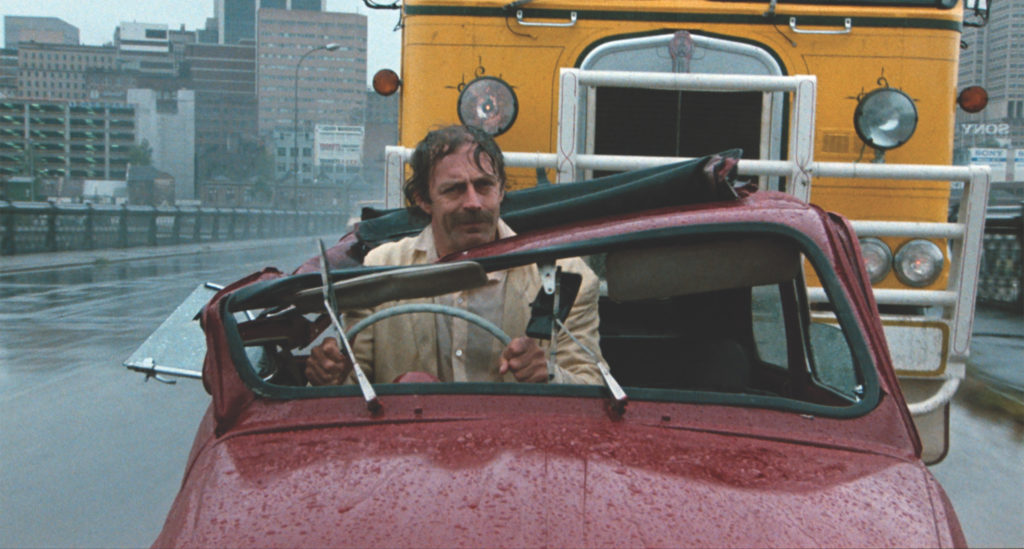
Between heaven and hell
An early – close-to-three-hour – cut was sent to Cannes Film Festival general delegate Gilles Jacob, who expressed interest in screening it. There was expectation that the film would be considerably shortened once accepted into the festival. According to Buckley, Bliss was first selected in the Un Certain Regard section and then the Directors’ Fortnight before finally being invited into the main competition.[44]Buckley, Behind a Velvet Light Trap, op. cit., p. 255. It was screened late in the festival, and was one of two Australian films in competition (the other was Dušan Makavejev’s truly calamitous The Coca-Cola Kid). The festival itself included new films by many established and celebrated directors including Clint Eastwood, Jean-Luc Godard, Youssef Chahine, Kotcheff, Paul Schrader, Alan Parker, István Szabó and the eventual winner, Emir Kusturica (for When Father Was Away on Business).
For its premiere screening in Cannes, Bliss was cut to around 135 minutes, considerably shorter than the rough and fine cuts submitted to the festival, but still twenty-three minutes or so longer than it would ultimately be pared down to for general release. As I mentioned earlier, the response to the initial press screenings was particularly hostile and deflating for Lawrence and Buckley. These were the screenings that were the focus of the attacks on the film that appeared in the Australian press over the next few weeks and that, ironically, helped fuel some public interest as well. The key thing that was commonly reported was the 400 or so who walked out of the first screening – and the sound of the regular, almost musical, flapping of emptied seats – as well as the audience’s reaction to some of the film’s more outrageous moments (such as the cockroaches seeping from Harry’s chest). Less widely reported were the positive reviews filed by some members of the international press. Although few Australian correspondents were actually present in Cannes, Kevin Childs, a reporter for The Age who did attend, provided a more balanced initial response: ‘At the end of the film some of the remaining audience booed while others cheered.’[45]Kevin Childs, ‘Australian Film Not Bliss for Everyone at Cannes’, The Age, 20 May 1985. He accounts for the generally negative response from the international press – ‘Bliss and a Canadian film, Joshua Then and Now [Kotcheff], tied for the worst reviews by critics from 12 countries’ – and reports on ‘a sparsely attended press conference’ at which Lawrence ‘looked around, grinned and said: “I was not expecting anyone to be here.”’[46]ibid. The film was also savaged by French critics. But he also notes the very positive reaction of Malcolm in The Guardian, and allows Buckley to give voice to the challenge laid down by the movie: ‘It is not a film that you can sit down and enjoy. You have to work at it.’[47]Anthony Buckley, quoted in ibid. The Canberra Times was much less balanced, claiming that ‘Bliss, in the wake of the earlier Australian entry, Dusan Makavejev’s The Coca-Cola Kid, confirmed outsider’s fears about the artistic health of the Australian industry’ more generally.[48]‘Film “Torture” for Cannes Critics’, op. cit. In the following weeks, Glover filed a series of stories for The Sydney Morning Herald that aimed to question the validity of this negative reaction, singling out particular journalists for their lack of care and bias in reporting on the film:
Dorian Wild, a columnist for The Daily Telegraph, was typical. His views of the matter were published under the heading, ‘Caning at Cannes makes Bliss prime bomb’. He called Peter Carey the ‘radically chic author’ and called the screenings ‘disastrous’. He said ‘the movie version of Bliss is bombing so badly at this year’s Cannes film orgy the tremors are being felt on the Richter scale’.[49]Glover, ‘Media Slaughters Good Chance for Bliss’, op. cit.
In some ways, it is unsurprising that Bliss struggled to attain local distribution, despite the critical acclaim previously afforded Carey’s novel.
This initial response lies in contrast to the many gushing accounts that routinely appear in the local press when an Australian film is screened at overseas festivals. Although I don’t wish to underplay the caustic undertone of these reports, they do also reflect the discomfort produced by the film itself. In some ways, it is unsurprising that Bliss struggled to attain local distribution, despite the critical acclaim previously afforded Carey’s novel. It was initially given an R certificate by the Commonwealth Film Censorship Board, specifically for the passages depicting incest between Harry’s children and the restaurant sex scene, before being downgraded to M on appeal. But Bliss was also considered by many in the industry to be severely limited in its box-office potential. Relegating it to an arthouse release, the ‘independent distributor and exhibitor Ronin Films estimated film rental to be [A]$100,000’.[50]Buckley, Behind a Velvet Light Trap, op. cit., p. 258. Ultimately, Buckley, Lawrence and the NSWFC were offered deals with Hoyts and Greater Union, signing with the latter to occupy the 173-seat State 2 in Sydney and one of the smaller cinemas at the Greater Union Russell Street complex in Melbourne. After it won the AFI Awards for Best Film, Best Direction and Best Adapted Screenplay, Bliss was granted a chance to perform at a significantly larger cinema in Pitt Street for an initial run of two to three weeks. Although it is difficult to get an accurate sense of its audience reception – Buckley claims that it initially screened to full houses for two sessions each day (7.30pm and 9.45pm), and ‘played the Pitt in Sydney for three months [and] then moved to our original home, State 2, for another three months’[51]ibid., p. 263. – its box-office performance certainly outstripped many people’s expectations, particularly for such a challenging and unusual movie. Buckley claims that Bliss achieved a gross of over A$1.3 million and a film rental of A$372,000 in Australia,[52]ibid. though the most commonly cited figure is A$1,144,663.[53]See Film Victoria, ‘Australian Films at the Australian Box Office’, 2009, available at <https://www.yumpu.com/en/document/view/20835692/australian-films-at-the-australian-box-office-446kb-film-victoria>, accessed 2 November 2020. This report was put together in 2009 and calculates Bliss’ inflation-adjusted result as A$2,724,774. It was sold to New World Pictures for overseas release,[54]Although New World Pictures was founded by Roger Corman and specialised in genre and exploitation movies, it also distributed films by significant international directors such as Fellini and François Truffaut in the United States. with Screen Australia reporting that it grossed US$660,537 in the United States.[55]‘Top Australian Films in the US, UK and Germany’, Screen Australia website, updated February 2020, <https://www.screenaustralia.gov.au/fact-finders/cinema/australian-films/top-films-at-the-box-office/top-australian-films-in-the-us,-uk-and-germany>, accessed 11 November 2020. This list places Bliss in ninetieth position in terms of all-time earnings for Australian movies at the US box office.
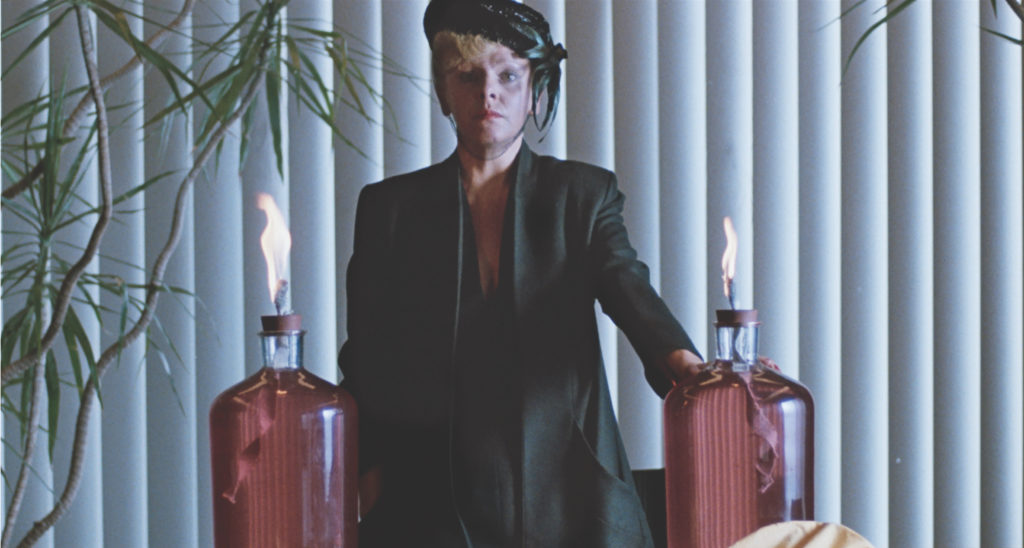
Although it plainly didn’t return its production budget on first release – a very small number of Australian films ever do – Bliss still performed comparatively well on local and international screens, especially considering its arguably calamitous premiere at Cannes, lack of well-known actors, and unconventional content and form for the purposes of marketing. As Jonathan Rayner has suggested, ‘unlike the majority of contemporary Australian feature productions, Bliss seems superficially at least to evade a simple generic classification’.[56]Jonathan Rayner, ‘Adapting Australian Film: Ray Lawrence from Bliss to Jindabyne’, Studies in Australasian Cinema, vol. 3, no. 3, 2009, p. 297. Rayner goes on to misplace the film within the category of the ‘Australian Gothic’, but his initial instincts are fairly accurate.[57]ibid., p. 298. Although the influence of magic realism is plainly evident in the book and film, Bliss moves across and between genres and tones from scene to scene. This is partly reflected in the posters used to promote it. The key poster image used for the Australian release is taken from the opening moments, and depicts the narrator’s hooded and cloaked ‘mother’ (Sarah de Teliga) staring at the camera holding a cross. This image is part of what is called the ‘Vision Splendid’, a brief narrated opening scene illustrating a rural flood in the 1920s and describing the look of the woman’s eyes. It is a very striking composition – the watery haze of the background a combination of soft focus and the rain falling in the foreground – but it is hardly typical of the movie itself (but, then again, what is?). The image does evoke some of the more lyrical and religious elements and themes of the film, particularly the tricky passage between life and afterlife suggested by the scene’s Styx-like connotations, but it hardly prepares us for what is to follow. I’m not sure clarity is enhanced – or even sought – by the tagline placed at the top of the poster, either: ‘Through history, many great artists have depicted the tortures of Hell. But never before has anyone dared to suggest that Hell is a place where an elephant sits on your car.’ The newspaper advertisements also relied on a version of this image, but added mention of the AFI Awards won and the Cannes controversy as well as more prominently crediting Carey’s novel.[58]It is also worth noting that Bliss was released in some venues with an accompanying short, Waltzing Matilda (Richard Chataway & Michael Cusack, 1985), which had also won an AFI Award. This claymation short animates local fauna in response to Banjo Patterson’s poem/song. With its appeal to nationalism and use of brightly coloured animals, it is certainly an odd support program for Bliss.
Although there were some variations across the posters used to promote Bliss internationally, they generally parted from the key image used for the Australian release. Positioning the film more explicitly as a ‘black’ or ‘outrageous’ comedy, these posters rely upon a self-consciously designed composite image that combines random elements from the movie (an elephant sitting on a red car; a silhouette that looks a little like Harry; an explicit contrast between city and nature) with elements that are only tangentially related to it (a set of stairs that quizzically lead nowhere; a curvaceous woman painted with flames who looks very little like Honey Barbara and is holding an apple; a snake; elephants flying over the skyscrapers of a city; an extensive wooden deck on which everything is staged for some reason). Most of these posters also use a different tagline: ‘From the moment Harry Joy dropped dead … his life would never be quite the same.’ These vaguely connected elements play up the surrealist credentials of Bliss, directly referencing artists such as René Magritte in their design. But these posters also speak directly to the difficulties of categorising the film more generally. Although Bliss is often comic, exaggerated, absurd and even nightmarish, it can’t be encapsulated by the term or genre of ‘comedy’. The varied elements of the international posters were also commonly combined with quotes that cited the awards the film had won alongside the positive critical response of prominent writers like Thomson (for Film Comment) and Richard Corliss (for Time). While many of the quotes cement the film’s credentials as a ‘flipped-out’ comedy, another makes an interesting comparison with Terry Gilliam’s Brazil (1985). Thomson’s widely used verdict provides the most apt summation in this regard: ‘A turbulent, disturbing, picturesque comedy … one of the most original and inventive films of the decade.’ In the process, Bliss is partly reimagined as a Felliniesque dreamscape.
A ‘landmark Australian film’
Bliss was released in Sydney and Melbourne on 19 September 1985. As indicated earlier, the critical response was generally positive and, in some cases, hyperbolic in its verdict. In a review titled ‘A Flamboyantly Stylish Invitation to Seduction’, Neil Jillett, the notoriously curmudgeonly critic for The Age, provided a relatively balanced and even positive assessment that singled out Otto’s widely celebrated performance and commented on the film’s ambition and superiority to its source novel. But Jillett concluded by confessing that
I must reluctantly return to my first impression of Bliss. It is a film easier to admire than to enjoy. Still, there is plenty of pleasure to be had from it – and admiring an Australian film, being dazzled by the witty flair with which it presents the hypocrisy around us, is an experience that is far from losing its novelty.[59]Neil Jillett, ‘A Flamboyantly Stylish Invitation to Seduction’, The Age, 19 September 1985.
It was The Sydney Morning Herald, though, that provided the staunchest and most sustained support. This began with Glover’s defence against the gleefully negative campaign that emerged in the wake of the Cannes screening, titled ‘Media Slaughters Good Chance for Bliss’: ‘It was a brave project: a black, odd story; a cast without big names; a first-time director; a budget raised without underwriters, pre-sales and distributors.’[60]Glover, ‘Media Slaughters Good Chance for Bliss’, op. cit. Over the next four months, a series of reports appeared in this newspaper that highlighted the wrongheadedness of the initial kneejerk response. Byrnes published an article when Bliss’ Sydney screening venue was upgraded to the Pitt Centre (‘Award-winner gets Bigger Venue’);[61]Paul Byrnes, ‘Award-winner Gets Bigger Venue’, The Sydney Morning Herald, 17 September 1985. Glover provided a comparison to the general failure of other Australian films released in 1985 (‘Bliss is a Hit at the Box Office’);[62]Glover, ‘Bliss Is a Hit at the Box Office’, op. cit. and a report was filed when the movie was screened at the New York Film Festival (‘Big US Reception for Bliss Proves the Cynics Wrong’).[63]‘Big US Reception for Bliss Proves the Cynics Wrong’, The Sydney Morning Herald, 7 October 1985. This final story included comments from Buckley about the warm and knowing response of American audiences, a brief mention of the negative review that was published in The New York Times, and the audience award for best film that Bliss received (alongside Akira Kurosawa’s Ran [1985]).
But it was Byrnes’ review (‘Bliss – New Team Delivers Landmark Australian Film’) that cemented the film’s growing reputation. Calling it ‘a landmark in the renaissance of Australian film’, he claimed it was
hard to imagine how this film could have been improved. Perhaps it is still a shade too long, and there are a couple of minor problems to do with the narrative structure, but in all other respects Bliss seems to be the movie that we have long been waiting for from the Australian film industry.[64]Byrnes, ‘New Team Delivers Landmark Australian Film’, op. cit.
This gushing response highlighted the film’s singularity, but it also provided an evaluation that sat in stark and deliberate contrast to those initial reports. As Byrnes later surmised:
Bliss is a key film in the story of Australian movies. It represents a kind of liberation point – a leap away from naturalism and the historical realism of the ‘new wave’ of the 1970s, towards the modernism of the 1990s. To say it was ahead of its time is an understatement – the boldness of its metaphors and the sharpness of its satire were too much for many people in 1985.[65]Paul Byrnes, ‘Curator’s Notes’, ‘Bliss (1985)’, Australian Screen, <https://aso.gov.au/titles/features/bliss/notes/>, accessed 11 November 2020.
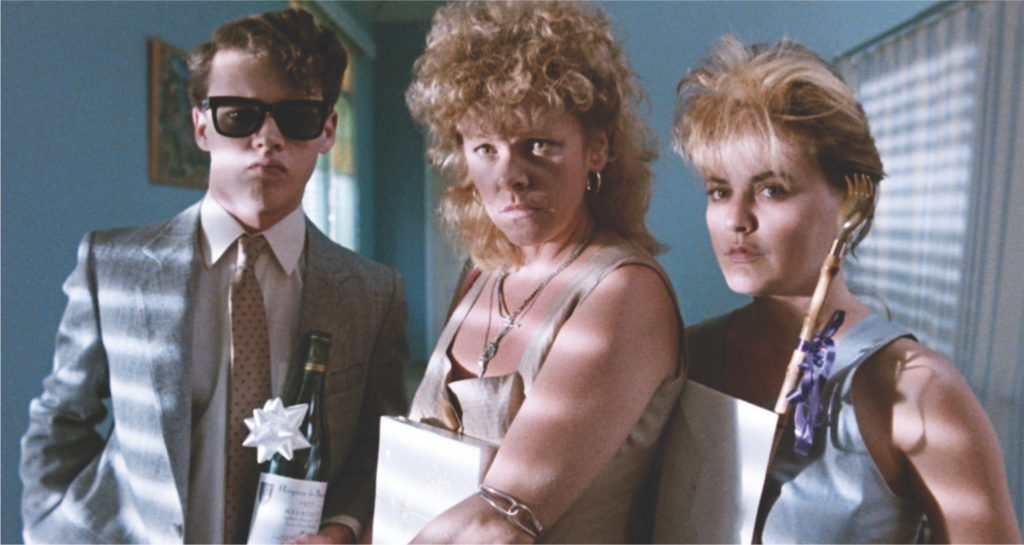
In his review for Cinema Papers, Stratton also used the Cannes reception to argue for the emergence of a more self-confident and self-sustaining local industry: ‘The accepted notion that Australian films – or music, or theatre – will find acceptance at home only after they have received accolades abroad has been turned on its head.’[66]David Stratton, ‘A Matter of Life and Death’, Cinema Papers, no. 54, November 1985, p. 65. Stratton also claimed that the film’s iconoclastic and atypical elements needed to be celebrated and encouraged: ‘If Bliss succeeds (as it unquestionably deserves to), then perhaps other producers with off-beat productions will also go the way of self-distribution. And, God knows, we need more off-beat productions.’[67]ibid. But part of this freshness is also a matter of how little the film relates to and references earlier Australian cinema.
Bliss’ legacy: Telling stories and planting trees
Stratton’s and Byrnes’ comments help us to frame the legacy of Bliss over thirty-five years later. It is both a film very much of its moment in time and a work difficult to place within any particular genre, movement or tradition. I’m less sure, as Byrnes asserts, that it’s a rare Australian ‘movie of ideas’,[68]Byrnes, ‘New Team Delivers Landmark Australian Film’, op. cit. but it is certainly remarkable for the ways it careens between satire, surrealism, social realism, Kafkaesque absurdity, Felliniesque dreamscapes, eager vulgarity, Dantesque visions of heaven and hell, modern fable, and religious parable, among many other things. Although at times it is a little too eager to shock – I can do without seeing some of the more self-consciously grotesque images again anytime soon – it remains a fascinating combination of art movie and something a little closer to ‘ocker’ comedy.
But these much-commented-upon elements and moments are contrasted with smaller and more minutely observed interactions between characters. For example, there is a lovely scene between Harry and Reverend Des (Chubb) while the former is recuperating in hospital. Simply shot on a porch dappled with light, this careful scene demonstrates the filmmakers’ capacity to work in a quieter register that leans upon a more subtle physicality. As the chatty, large-boned Reverend is wedged up against the wiry Harry, they talk about God, punishment, eternity and the material realities of hell. But this conversation – in the hands of these two actors situated within a neutral space – takes on a more colloquial quality: ‘Do you think that God is such a bastard that he’d want to torture you for all eternity?’ proffers Des. Stricken by the fevered intensity of Harry’s questioning about the realities of hell, Des also questions whether ‘maybe we should have spoken about cricket’ instead. The contrasts between the sizes of the two actors and the way that each views the world emphasise another key element: scale. Bliss moves restlessly between the microscopic and the macroscopic, between the large and the small, between the extreme long shot and the medium close-up. This quiet scene links to other moments throughout, but also prepares the way for the movie’s latter stages; as Lawrence describes it, ‘The film is in two sections. There’s a very surrealistic opening half and, then, once Harry goes to the bush, everything becomes normal.’[69]Ray Lawrence, quoted in Peter Malone, ‘Ray Lawrence’, Peter Malone author website, 30 October 1998, <http://petermalone.misacor.org.au/tiki-index.php?page=Ray+Lawrence>, accessed 11 November 2020. Commenting thirteen or so years after the production, the director also claimed:
In terms of my progress, I’m more interested in the last half of the movie now, but then I was really into the other half – and I think a lot of people still think I’m very visual or something.[70]ibid.
Bliss’ legacy also lies in its focus on ecology and environmentalism. This is most evident in the last section, when Harry retreats to the rainforest to begin the long process of expressing his love for and seeking his forgiveness from Honey Barbara. These calmer and explicitly romantic final passages sit in contrast to the penultimate scenes set in the city, which climax with Bettina’s self-immolation during a meeting with petrol-company executives. A strong element of the film’s satire focuses on the cancer-inducing properties of contemporary consumer products, including the petrol that Bettina has so enthusiastically built advertising campaigns around and that has granted her a death sentence. Although she becomes a little corrupted by her life in the city as well as during her stay with the Joy family, Honey Barbara represents the possibilities of another way of living, away from the perils, dangers and temptations of modern life. Despite its quieter moments, Bliss is often quite manic in its humour, staging and storytelling prior to this Edenic finale. But it is this return to nature, the power of gesture and the rhythms of daily life that mark the film’s conclusions. Harry plants trees that will attract bees and allow Honey Barbara to collect honey during a normally barren time of the year. The confused, disparate, fast-paced passage of time that has characterised much of Bliss and its storytelling makes way for a deeper sense of duration and ecological time, as Harry’s gentle narrator intones: ‘Only a crazy man would write a love letter that takes eight years to arrive.’ But this slow, poetic gesture also brings humanity and nature into ecological alignment: ‘Her bees had found my love letter and delivered it as planned.’ After this, all that is left is for the story to be passed on to the children of Harry Joy and Honey Barbara, and for their daughter (played by Saskia Post) to recount Harry’s inevitable death many years later – when a branch falls on him from one of his trees – and provide a brief, essentialist obituary: ‘He was Harry Joy. He was our father. He told stories and he planted trees.’ These final moments combine the true legacy of each.
Like these slow-growing trees, Bliss remains a film to be rediscovered. It is hardly a forgotten work, but it has suffered from a relative lack of visibility, the limited availability of decent copies and the difficulty of placing it within dominant traditions of Australian cinema. Despite this, it was released on DVD in 2010 in its extended cut,[71]See Bliss: Director’s Cut, DVD, Umbrella Entertainment, 2010. The film was also released on video by CEL in June 1986. has been routinely discussed in relation to Lawrence’s other film work during that decade, and has also been restored by the National Film and Sound Archive of Australia in its 112-minute original theatrical-release version.[72]My analysis of the film refers to the longer producer-and-director-sanctioned version, and reflects the common form in which the film is currently available on DVD and in other digital versions. This restoration received its premiere at the 2016 Sydney Film Festival, although it has not been widely shown outside of this forum. As I hope I have demonstrated here, Bliss remains a rich, deeply idiosyncratic and even prescient work of Australian cinema that provides fascinating insights into the local, national and international circulation of films in the 1980s as well as a model of adaptation and collaboration.
This article has been refereed.
Select bibliography
Anthony Buckley, Behind a Velvet Light Trap: A Filmmaker’s Journey from Cinesound to Cannes, Hardie Grant Books, Prahran, Vic., 2009, pp. 246-64.
Paul Byrnes, ‘Bliss – New Team Delivers Landmark Australian Film’, The Sydney Morning Herald, 19 September 1985.
Peter Carey, Bliss, London, Picador, 1982.
Robert Dixon, ‘Peter Carey’s and Ray Lawrence’s Bliss (1985): Fiction, Film and Power’, Studies in Australasian Cinema, vol. 3, no. 3, 2009, pp. 279–94.
Peter Galvin, ‘Bliss in a Sometimes Joyless World’, Cinema Papers, no. 54, November 1985, pp. 16–7.
Richard Glover, ‘Media Slaughters Good Chance for Bliss’, The Sydney Morning Herald, 10 June 1985.
Peter Malone, ‘Ray Lawrence’, Peter Malone author website, 30 October 1998, <http://petermalone.misacor.org.au/tiki-index.php?page=Ray+Lawrence&bl>.
Scott Murray, ‘Bliss’, in Murray (ed.), Australian Film 1978–1994, Oxford University Press, Melbourne, 1995, p. 164.
Jonathan Rayner, ‘Adapting Australian Film: Ray Lawrence from Bliss to Jindabyne’, Studies in Australasian Cinema, vol. 3, no. 3, 2009, pp 295–308.
Theodore F Sheckels, ‘Filming Peter Carey: From the Adequate to the Distorted’, Antipodes, December 1999, pp. 91–4.
David Stratton, ‘A Matter of Life and Death’, Cinema Papers, no. 54, November 1985, p. 65.
David Stratton, The Avocado Plantation: Boom and Bust in the Australian Film Industry, MacMillan, Sydney, 1990, pp. 172–7.
MAIN CAST
Harry Joy Barry Otto Bettina Joy Lynette Curran Honey Barbara Helen Jones David Joy Miles Buchanan Lucy Joy Gia Carides Alex Duval Tim Robertson Joel Jeff Truman Adrian Clunes Bryan Marshall Aldo Jon Ewing Alice Dalton Kerry Walker Rev Des Paul Chubb
PRINCIPAL CREDITS
Year of Release 1985 Length 112/135 minutes Director Ray Lawrence Screenplay Peter Carey & Ray Lawrence, based on the novel by Peter Carey Production Company Window III Productions & New South Wales Film Corporation Producer Anthony Buckley Production Manager Carol Hughes Director of Photography Paul Murphy Editor Wayne Le Clos Art Direction Owen Paterson Costume Design Helen Hooper Music Peter Best
Endnotes
| 1 | See, for example, Paul Byrnes, ‘Bliss – New Team Delivers Landmark Australian Film’, The Sydney Morning Herald, 19 September 1985. |
|---|---|
| 2 | Susan Dermody, ‘The Company of Eccentrics’, Filmnews,1 December 1988, p. 6. |
| 3 | O’Regan divides the ‘films’ of the 1980s into four dominant categories: genre, art film, blockbusters and TV miniseries. See Tom O’Regan, ‘The Enchantment with Cinema: Film in the 1980s’, in Albert Moran & O’Regan (eds), The Australian Screen, Penguin Books, Ringwood, Vic., 1989, p. 130. |
| 4 | Scott Murray, ‘Bliss’, in Murray (ed.), Australian Film 1978–1994, Oxford University Press, Melbourne, 1995, p. 164. |
| 5 | Scott Murray, ‘Australian Cinema in the 1970s and 1980s’, in Murray (ed.), Australian Cinema, Allen & Unwin & Australian Film Commission, St Leonards, 1994, p. 134. |
| 6 | David Stratton, The Avocado Plantation: Boom and Bust in the Australian Film Industry, MacMillan, Sydney, 1990, p. 177. |
| 7 | Peter Carey, Bliss, London, Picador, 1982. Carey’s novel was first published in 1981 and won the Miles Franklin Award for that year. It also won the Christina Stead Prize for Fiction in the New South Wales Premier’s Literary Awards the following year. |
| 8 | This is particularly in reference to reports that appeared in newspapers such as Sydney’s The Daily Telegraph. But similar reports also appeared elsewhere: see, for example, ‘Film “Torture” for Cannes Critics’, The Canberra Times, 20 May 1985. This brief report also quotes Lawrence claiming he ‘felt like a criminal’ after the shock of seeing ‘40 people in front of [him] stand up and walk out’ at this initial screening. These reports mostly refer to the Cannes press screenings rather than the Gala showing of Bliss at the festival the following day. |
| 9 | Division 10BA was first introduced in June 1981. It allowed investors to claim a 150 per cent tax concession on specific film investments. This percentage was gradually decreased across the decade. Most of the features produced during the period of its operation, including Bliss, were funded – at least in part – by these tax concessions. It led to increased production levels and budgets, and a higher percentage of movies that didn’t receive a theatrical release. |
| 10 | Richard Glover, ‘Media Slaughters Good Chance for Bliss’, The Sydney Morning Herald, 10 June 1985. |
| 11 | The recommendations of Thomson and Malcolm were central to getting the film invited to the New York and London film festivals. |
| 12 | Anthony Buckley, Behind a Velvet Light Trap: A Filmmaker’s Journey from Cinesound to Cannes, Hardie Grant Books, Prahran, Vic., 2009, pp. 256–7. Buckley’s is, by some distance, the most detailed published account of Bliss’ production and release. |
| 13 | ibid., p. 257. |
| 14 | Ray Lawrence, quoted in Glover, ‘Media Slaughters Good Chance for Bliss’, op. cit. |
| 15 | See Richard Glover, ‘Bliss Is a Hit at the Box Office’, The Sydney Morning Herald, 26 September 1985. In this article, Glover compares average box-office takings per week per cinema for a range of Australian films released in 1985. Bliss’ per-screen average of A$30,000 compares very favourably to Robbery Under Arms (A$4300) and The Naked Country (A$2800). |
| 16 | Witness is, of course, an American-produced and -shot film, but it was still commonly brought into these discussions due to several of its key production personnel being Australian. |
| 17 | For a discussion of the ‘outward-looking’ trend in contemporary Australian cinema, see Ben Goldsmith, ‘Outward-looking Australian Cinema’, Studies in Australasian Cinema, vol. 4, no. 3, 2010, pp. 199–214. |
| 18 | Despite being released over thirty years ago, Crocodile Dundee remains by far the most financially successful Australian film released at the local box office. Its only competition are several international blockbusters made by Miller and Baz Luhrmann that also attained significant overseas success but were largely financed by Hollywood studios. For more on the film and its legacy, see Jake Wilson, ‘Hogan’s Heroes: Star Image in Dean Murphy’s The Very Excellent Mr. Dundee’, in this issue of Metro, pp. 18–21. |
| 19 | I will discuss these censorship problems later in this article, but these mainly revolved around the film initially receiving an R rating and the negative impact this would likely have had on its commercial fate. |
| 20 | The twenty-seventh AFI Awards took place in Sydney on Saturday 14 September 1985. The ceremony also included a truly bizarre musical number featuring three dancers representing the two central characters from Bliss and the ‘religious’ figure glimpsed in the film’s opening moments and featured on its poster design. The brevity of this performance was, I’m sure, a relief to everyone. |
| 21 | Buckley, Behind a Velvet Light Trap, op. cit., pp. 261–2. On its initial run, Bliss was screened at a smaller venue in Melbourne. |
| 22 | Byrnes, ‘New Team Delivers Landmark Australian Film’, op. cit. |
| 23 | Susan Dermody & Elizabeth Jacka, quoted in Robert Dixon, ‘Peter Carey’s and Ray Lawrence’s Bliss (1985): Fiction, Film and Power’, Studies in Australasian Cinema, vol. 3, no. 3, 2009, pp. 283–4. |
| 24 | ibid., p. 284. |
| 25 | Lawrence worked in advertising in the UK and Australia during the 1960s and 1970s. |
| 26 | Some of the most fondly remembered of Lawrence’s commercials are for Bornhoffen bread, Holeproof and the Yellow Pages (featuring a character searching the directory for someone who’s heard of a Goggomobil). Each is carefully cast and relies upon a strong – if brief – story. For example, his commercial for Holeproof Computer Socks places this product’s ‘inventor’ alongside Isaac Newton on a bench outside a patent office. The theory of gravity is contested between the two of them, with Computer Socks refuting Newton’s theorem. |
| 27 | Michael Meagher, ‘Ray Lawrence Feels Bliss, at Last’, The Bulletin, vol. 104, no. 5411, 10 April 1984, p. 75. |
| 28 | Lawrence was involved in developing several other projects across this period, including an early planned adaptation of Robyn Davidson’s Tracks. The subject of numerous iterations, it was finally adapted to screen by John Curran and released in 2013. Careful adaptation has remained a key element of all of Lawrence’s feature films. |
| 29 | Buckley had previously worked as an editor for Cinesound and Channel Ten. |
| 30 | Prior to Bliss, Buckley had also produced The Irishman (Crombie, 1978), The Night, the Prowler (Jim Sharman, 1978), The Killing of Angel Street (Crombie, 1981) and Kitty and the Bagman (Crombie, 1982). |
| 31 | For more on True History of the Kelly Gang, see ‘The Pen Is Mightier than the Gun: Justin Kurzel’s True History of the Kelly Gang and Punk Historiography’, Metro, no. 203, 2020, pp. 6–13. Carey was also the co-writer of the screenplay of Wim Wenders’ Until the End of the World (1991). |
| 32 | Buckley, Behind a Velvet Light Trap, op. cit., p. 245. |
| 33 | Anthony Buckley, quoted in Peter Galvin, ‘Bliss in a Sometimes Joyless World’, Cinema Papers, no. 54, November 1985, p. 16. |
| 34 | Buckley recounts the difficulties he encountered while trying to persuade the NSWFC to take the unusual step of supporting the production in this way. The NSWFC also put forward the name of a company, Quantum, that helped raise the significant private investment required. See Buckley, Behind a Velvet Light Trap, op. cit., pp. 247–8. |
| 35 | Stratton, The Avocado Plantation, op. cit., p. 175. The number that made it into the final cut is considerably lesser, but still substantial. |
| 36 | Buckley, Behind a Velvet Light Trap, op. cit., p. 249. |
| 37 | Lawrence also first encountered Otto when working on a commercial. See Meagher, op. cit., p. 75. |
| 38 | Murphy had previously worked on a range of features including The F.J. Holden (Michael Thornhill, 1977), In Search of Anna (Esben Storm, 1978) and Manganinnie (John Honey, 1980). Coincidentally, his next credit as DOP was for another Carey adaptation, Dead End Drive-In. |
| 39 | Buckley, Behind a Velvet Light Trap, op. cit., p. 250. |
| 40 | Stratton, The Avocado Plantation, op. cit., p. 175. |
| 41 | Buckley, Behind a Velvet Light Trap, op. cit., p. 254. |
| 42 | ibid., p. 252. |
| 43 | Stratton, The Avocado Plantation, op. cit., p. 176. |
| 44 | Buckley, Behind a Velvet Light Trap, op. cit., p. 255. |
| 45 | Kevin Childs, ‘Australian Film Not Bliss for Everyone at Cannes’, The Age, 20 May 1985. |
| 46 | ibid. The film was also savaged by French critics. |
| 47 | Anthony Buckley, quoted in ibid. |
| 48 | ‘Film “Torture” for Cannes Critics’, op. cit. |
| 49 | Glover, ‘Media Slaughters Good Chance for Bliss’, op. cit. |
| 50 | Buckley, Behind a Velvet Light Trap, op. cit., p. 258. |
| 51 | ibid., p. 263. |
| 52 | ibid. |
| 53 | See Film Victoria, ‘Australian Films at the Australian Box Office’, 2009, available at <https://www.yumpu.com/en/document/view/20835692/australian-films-at-the-australian-box-office-446kb-film-victoria>, accessed 2 November 2020. This report was put together in 2009 and calculates Bliss’ inflation-adjusted result as A$2,724,774. |
| 54 | Although New World Pictures was founded by Roger Corman and specialised in genre and exploitation movies, it also distributed films by significant international directors such as Fellini and François Truffaut in the United States. |
| 55 | ‘Top Australian Films in the US, UK and Germany’, Screen Australia website, updated February 2020, <https://www.screenaustralia.gov.au/fact-finders/cinema/australian-films/top-films-at-the-box-office/top-australian-films-in-the-us,-uk-and-germany>, accessed 11 November 2020. This list places Bliss in ninetieth position in terms of all-time earnings for Australian movies at the US box office. |
| 56 | Jonathan Rayner, ‘Adapting Australian Film: Ray Lawrence from Bliss to Jindabyne’, Studies in Australasian Cinema, vol. 3, no. 3, 2009, p. 297. |
| 57 | ibid., p. 298. |
| 58 | It is also worth noting that Bliss was released in some venues with an accompanying short, Waltzing Matilda (Richard Chataway & Michael Cusack, 1985), which had also won an AFI Award. This claymation short animates local fauna in response to Banjo Patterson’s poem/song. With its appeal to nationalism and use of brightly coloured animals, it is certainly an odd support program for Bliss. |
| 59 | Neil Jillett, ‘A Flamboyantly Stylish Invitation to Seduction’, The Age, 19 September 1985. |
| 60 | Glover, ‘Media Slaughters Good Chance for Bliss’, op. cit. |
| 61 | Paul Byrnes, ‘Award-winner Gets Bigger Venue’, The Sydney Morning Herald, 17 September 1985. |
| 62 | Glover, ‘Bliss Is a Hit at the Box Office’, op. cit. |
| 63 | ‘Big US Reception for Bliss Proves the Cynics Wrong’, The Sydney Morning Herald, 7 October 1985. |
| 64 | Byrnes, ‘New Team Delivers Landmark Australian Film’, op. cit. |
| 65 | Paul Byrnes, ‘Curator’s Notes’, ‘Bliss (1985)’, Australian Screen, <https://aso.gov.au/titles/features/bliss/notes/>, accessed 11 November 2020. |
| 66 | David Stratton, ‘A Matter of Life and Death’, Cinema Papers, no. 54, November 1985, p. 65. |
| 67 | ibid. |
| 68 | Byrnes, ‘New Team Delivers Landmark Australian Film’, op. cit. |
| 69 | Ray Lawrence, quoted in Peter Malone, ‘Ray Lawrence’, Peter Malone author website, 30 October 1998, <http://petermalone.misacor.org.au/tiki-index.php?page=Ray+Lawrence>, accessed 11 November 2020. |
| 70 | ibid. |
| 71 | See Bliss: Director’s Cut, DVD, Umbrella Entertainment, 2010. The film was also released on video by CEL in June 1986. |
| 72 | My analysis of the film refers to the longer producer-and-director-sanctioned version, and reflects the common form in which the film is currently available on DVD and in other digital versions. |
